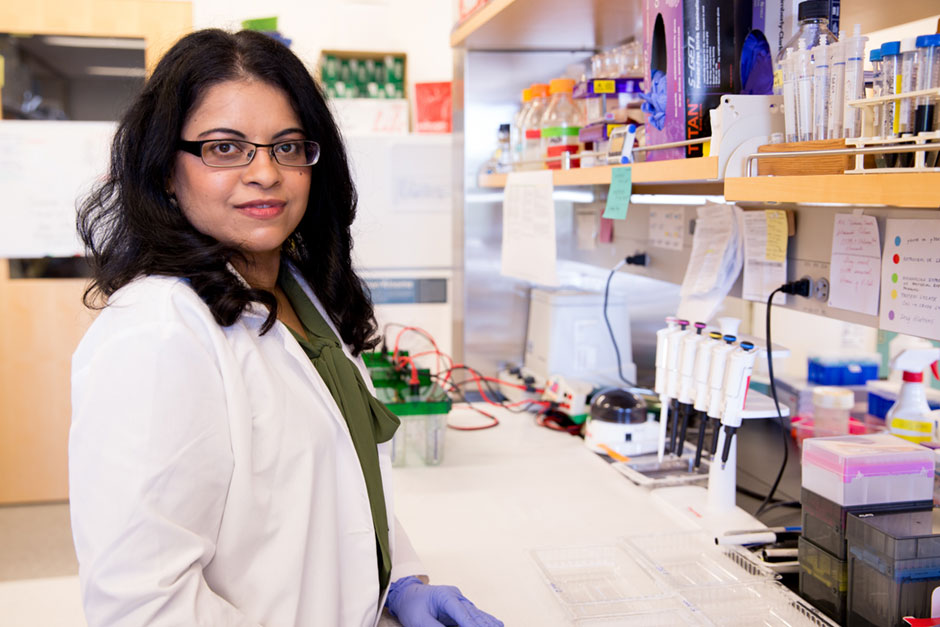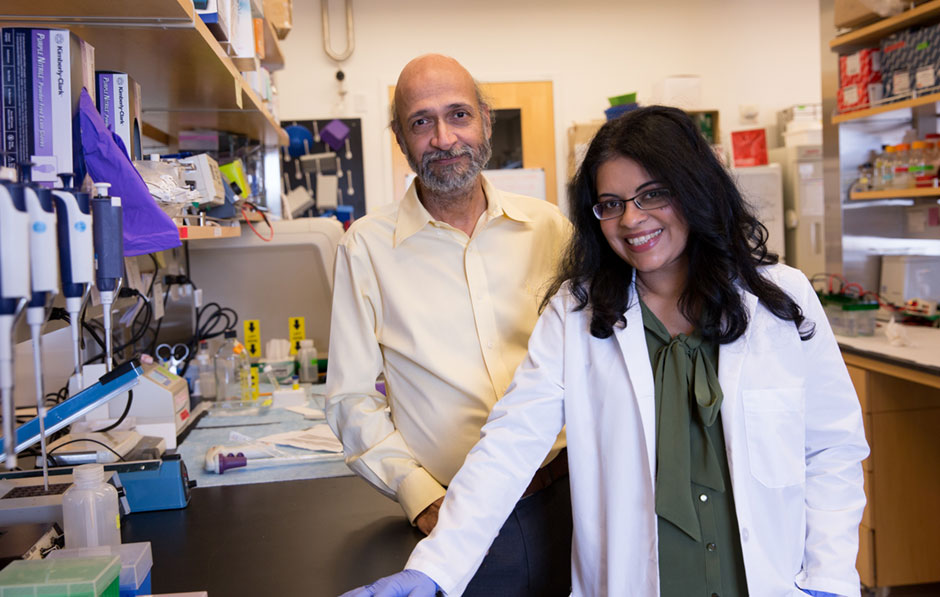Treatments for childhood cancers are harsh on kids’ bodies. While survival rates have improved dramatically over the last few decades, quality of life has not. Therapies such as chemotherapy and radiation can lead to learning disabilities, nerve damage, fertility issues and other health problems. OHSU cancer researchers are working to change that.
Monika Davare, PhD, assistant professor of pediatrics in the Division of Hematology and Oncology at OHSU, recently received a grant for $99,906 from the St. Baldrick’s Foundation to pursue research that would use the body’s immune system to fight cancer cells.
Cancer cells hide in plain sight of the immune system because they have evolved to escape recognition. Davare’s goal is to uncloak cancer cells so a patient’s immune cells can attack the disease. For this project, Davare, who leads a lab at OHSU Doernbecher Children’s Hospital, is collaborating with Ujwal Shinde, PhD, in OHSU’s Department of Biochemistry. Drs. Davare and Shinde are developing an innovative method to identify synthetic molecules that will uncloak cancer cells to make them visible to the immune system.
St. Baldrick’s Foundation has given more than $1.47 million in grants to Doernbecher cancer researchers since 2006.
This approach and concept can be applied to a wide range of cancers in both kids and adults.
Dr. Davare’s grant from the St. Baldrick’s Foundation is one of 90 grants totaling more than $23 million that the foundation funded this summer to support the work of pediatric cancer researchers throughout the U.S.
St. Baldrick’s Foundation has given more than $1.47 million in grants to Doernbecher cancer researchers since 2006.
Previous OHSU recipients of St. Baldrick’s Foundation grants include Linda Stork, MD, Bill Hoon Chang, MD, PhD, Peter Kurre, MD and Yoon-Jae Cho, MD, investigating pediatric brain tumors, acute lymphoblastic leukemia, acute myeloid leukemia and more. Several Doernbecher fellows in training have also been awarded St. Baldrick’s Foundation Fellowship grants.

Q&A with Monika Davare, PhD
Is this your first study involving uncloaking cancer cells and using the immune system to attack them?
Yes, this is a new area for me. Until recently, the majority of my work has focused on identifying molecular pathways that live inside the cancer cell to drive their uncontrolled growth and other cancer-like properties. In some cancer types this is easier, because there are not that many mutations or genomic aberrations (mistakes in DNA). But in some cancer patients, the number of genomic aberrations is so vast that identifying any one or a few pathways to target is challenging. And even if we can, these types of cancer cells very quickly adapt and bypass the treatment option, and patients develop resistance. This results in a bottleneck to developing targeted drugs or to accomplishing durable, long-term responses to therapy. It is due to these challenges that I started thinking about the recent advances and research that have shown promise in reawakening the immune system to target the tumor.
Immunotherapy seems to be the big word these days – many researchers are pursuing it. How is your work different?
Cancer cells are sneaky. They find ways to silence the immune cells that are among them. One of these immune-evasive signals that lives on the surface of the tumor cell has been coined the “don’t eat me” protein. Immunotherapy is a rapidly growing area, and many people are developing therapeutic entities called antibodies whose job is to block signals like the “don’t eat me” protein. By blocking this signal, the immune cell is reawakened and can attack and destroy the cancer cell. Antibodies do work, but are very expensive to produce, take a long time to develop and have other pragmatic liabilities like penetration into solid tumors, short shelf life, fungal and bacterial contamination, etc.
We are developing a different and new way of blocking this immune-evasive “don’t eat me” signal with synthetic molecules that don’t face the same limitations as antibodies. In theory, these entities should do what therapeutic antibodies do, but are easier to make and store, are about ten times smaller and can be quickly altered in case patients develop resistance. In the long term, we envision these synthetic molecules to work as “theranostic” entities: agents that can be used both for diagnostic and therapeutic purposes. It is an exciting new project that I hope yields something new for us to take into the clinical realm someday.
It sounds like this research applies to both pediatric and adult cancers. Is that right?
Yes, this is correct. Research and development efforts to bring new therapies for cancer to the clinic no longer are focused on adult or pediatric cancer as distinct silos, rather they are directed towards the molecular features of the tumor. In some cases, a pediatric cancer may share the same molecular or genetic characteristics as an adult cancer, potentially even from different parts of the body. So our work is applicable to various cancers in all ages.
I am particularly interested in pediatric cancer because the biology of some of these tumor types is not very well defined. More importantly, pediatric cancer survivors face a lifetime of consequences related to cytotoxic treatments. It is imperative to find really targeted or more selective treatments for kids with cancer. Our hope and goal is to actualize the promise of precision medicine for pediatric patients the same way we are seeing breakthroughs happen on the adult side.
How important are grants like this to your work?
My approach is a new way of thinking about reactivating the immune system in cancer. And any new idea has an inherently higher risk than a project that is incrementally pushing something already known to next stage. Frequently, federal agencies are more conservative and prefer to see extensive preliminary data or proof of concept studies already done before they are willing to fund.
It is a quintessential ‘chicken or egg’ problem. Without data, federal agencies won’t fund; but without funding, it is hard to execute new discovery projects that have no prior precedence.
Therefore, investment by philanthropic foundations in new discovery research like this is necessary for us to be able to find disruptive or game-changing technologies and therapeutics. This is indeed a very important mechanism of funding bold new research in the current scientific landscape.




